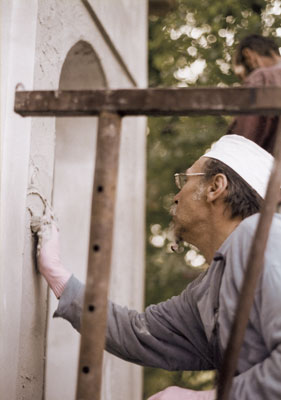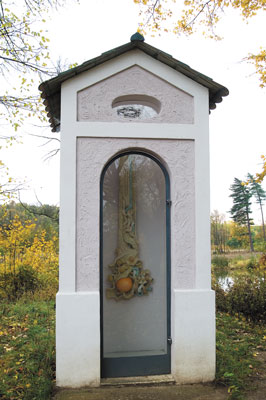 The station where the pilgrims discover a chapel with the ceramic sculptureThe Birth and Simultaneously Damnation of the Sphere (1978) is at a significant crossroads. A branch of the river which had to give way to progress (regulation of the river), the so-called Black Thaya, intersects here with the route of a former bridge which was destroyed at the end of the Second World War. In this place, with its powerful genius loci, Kristek built a chapel as a “witness of the times” with a deep philosophical scope and hope for the future. Forms are born and die, but the energy is omnipresent and indestructible. The author left his signature on more than just the sculpture in the chapel. He also left an impression in the plaster of the chapel, which he shaped with his own hands.
The station where the pilgrims discover a chapel with the ceramic sculptureThe Birth and Simultaneously Damnation of the Sphere (1978) is at a significant crossroads. A branch of the river which had to give way to progress (regulation of the river), the so-called Black Thaya, intersects here with the route of a former bridge which was destroyed at the end of the Second World War. In this place, with its powerful genius loci, Kristek built a chapel as a “witness of the times” with a deep philosophical scope and hope for the future. Forms are born and die, but the energy is omnipresent and indestructible. The author left his signature on more than just the sculpture in the chapel. He also left an impression in the plaster of the chapel, which he shaped with his own hands.
 The sphere represents the symbol of unity and at the same time the perfect spatial body. Each point on its surface is the same as the other points and is the same distance from the point at its centre. If we choose just one point on the surface of the sphere, we can designate other points in relation to it. One can even compare a person to the shape of the sphere. In the work of art, man represents the microcosm, and so his own shape must correspond to the macrocosm. And for this reason, man corresponds to the universe in his construction. The human soul has even been credited with having the shape of a sphere. Kristek created a sphere as a perfect form in his ceramic sculpture The Birth and Simultaneously Damnation of the Sphere located in the chapel. Here Kristek refined the sphere into a subject of consideration, contemplation and reflection. But at the same time, the sphere may constitute a warning of the uncertainty of worldly life and capricious nature of the bearer of luck, Fortuna.
The sphere represents the symbol of unity and at the same time the perfect spatial body. Each point on its surface is the same as the other points and is the same distance from the point at its centre. If we choose just one point on the surface of the sphere, we can designate other points in relation to it. One can even compare a person to the shape of the sphere. In the work of art, man represents the microcosm, and so his own shape must correspond to the macrocosm. And for this reason, man corresponds to the universe in his construction. The human soul has even been credited with having the shape of a sphere. Kristek created a sphere as a perfect form in his ceramic sculpture The Birth and Simultaneously Damnation of the Sphere located in the chapel. Here Kristek refined the sphere into a subject of consideration, contemplation and reflection. But at the same time, the sphere may constitute a warning of the uncertainty of worldly life and capricious nature of the bearer of luck, Fortuna.
Text: Barbora Půtová



